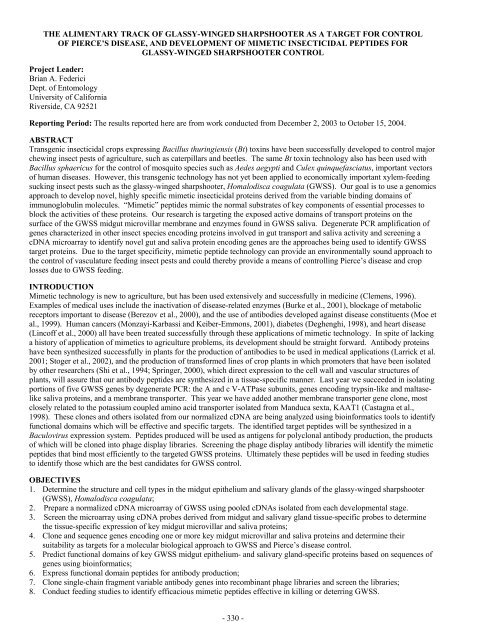Impact Of Host Plant Xylem Fluid On Xylella Fastidiosa Multiplication ...
Impact Of Host Plant Xylem Fluid On Xylella Fastidiosa Multiplication ...
Impact Of Host Plant Xylem Fluid On Xylella Fastidiosa Multiplication ...
You also want an ePaper? Increase the reach of your titles
YUMPU automatically turns print PDFs into web optimized ePapers that Google loves.
THE ALIMENTARY TRACK OF GLASSY-WINGED SHARPSHOOTER AS A TARGET FOR CONTROL<br />
OF PIERCE’S DISEASE, AND DEVELOPMENT OF MIMETIC INSECTICIDAL PEPTIDES FOR<br />
GLASSY-WINGED SHARPSHOOTER CONTROL<br />
Project Leader:<br />
Brian A. Federici<br />
Dept. of Entomology<br />
University of California<br />
Riverside, CA 92521<br />
Reporting Period: The results reported here are from work conducted from December 2, 2003 to October 15, 2004.<br />
ABSTRACT<br />
Transgenic insecticidal crops expressing Bacillus thuringiensis (Bt) toxins have been successfully developed to control major<br />
chewing insect pests of agriculture, such as caterpillars and beetles. The same Bt toxin technology also has been used with<br />
Bacillus sphaericus for the control of mosquito species such as Aedes aegypti and Culex quinquefasciatus, important vectors<br />
of human diseases. However, this transgenic technology has not yet been applied to economically important xylem-feeding<br />
sucking insect pests such as the glassy-winged sharpshooter, Homalodisca coagulata (GWSS). Our goal is to use a genomics<br />
approach to develop novel, highly specific mimetic insecticidal proteins derived from the variable binding domains of<br />
immunoglobulin molecules. “Mimetic” peptides mimic the normal substrates of key components of essential processes to<br />
block the activities of these proteins. Our research is targeting the exposed active domains of transport proteins on the<br />
surface of the GWSS midgut microvillar membrane and enzymes found in GWSS saliva. Degenerate PCR amplification of<br />
genes characterized in other insect species encoding proteins involved in gut transport and saliva activity and screening a<br />
cDNA microarray to identify novel gut and saliva protein encoding genes are the approaches being used to identify GWSS<br />
target proteins. Due to the target specificity, mimetic peptide technology can provide an environmentally sound approach to<br />
the control of vasculature feeding insect pests and could thereby provide a means of controlling Pierce’s disease and crop<br />
losses due to GWSS feeding.<br />
INTRODUCTION<br />
Mimetic technology is new to agriculture, but has been used extensively and successfully in medicine (Clemens, 1996).<br />
Examples of medical uses include the inactivation of disease-related enzymes (Burke et al., 2001), blockage of metabolic<br />
receptors important to disease (Berezov et al., 2000), and the use of antibodies developed against disease constituents (Moe et<br />
al., 1999). Human cancers (Monzayi-Karbassi and Keiber-Emmons, 2001), diabetes (Deghenghi, 1998), and heart disease<br />
(Lincoff et al., 2000) all have been treated successfully through these applications of mimetic technology. In spite of lacking<br />
a history of application of mimetics to agriculture problems, its development should be straight forward. Antibody proteins<br />
have been synthesized successfully in plants for the production of antibodies to be used in medical applications (Larrick et al.<br />
2001; Stoger et al., 2002), and the production of transformed lines of crop plants in which promoters that have been isolated<br />
by other researchers (Shi et al., 1994; Springer, 2000), which direct expression to the cell wall and vascular structures of<br />
plants, will assure that our antibody peptides are synthesized in a tissue-specific manner. Last year we succeeded in isolating<br />
portions of five GWSS genes by degenerate PCR: the A and c V-ATPase subunits, genes encoding trypsin-like and maltaselike<br />
saliva proteins, and a membrane transporter. This year we have added another membrane transporter gene clone, most<br />
closely related to the potassium coupled amino acid transporter isolated from Manduca sexta, KAAT1 (Castagna et al.,<br />
1998). These clones and others isolated from our normalized cDNA are being analyzed using bioinformatics tools to identify<br />
functional domains which will be effective and specific targets. The identified target peptides will be synthesized in a<br />
Baculovirus expression system. Peptides produced will be used as antigens for polyclonal antibody production, the products<br />
of which will be cloned into phage display libraries. Screening the phage display antibody libraries will identify the mimetic<br />
peptides that bind most efficiently to the targeted GWSS proteins. Ultimately these peptides will be used in feeding studies<br />
to identify those which are the best candidates for GWSS control.<br />
OBJECTIVES<br />
1. Determine the structure and cell types in the midgut epithelium and salivary glands of the glassy-winged sharpshooter<br />
(GWSS), Homalodisca coagulata;<br />
2. Prepare a normalized cDNA microarray of GWSS using pooled cDNAs isolated from each developmental stage.<br />
3. Screen the microarray using cDNA probes derived from midgut and salivary gland tissue-specific probes to determine<br />
the tissue-specific expression of key midgut microvillar and saliva proteins;<br />
4. Clone and sequence genes encoding one or more key midgut microvillar and saliva proteins and determine their<br />
suitability as targets for a molecular biological approach to GWSS and Pierce’s disease control.<br />
5. Predict functional domains of key GWSS midgut epithelium- and salivary gland-specific proteins based on sequences of<br />
genes using bioinformatics;<br />
6. Express functional domain peptides for antibody production;<br />
7. Clone single-chain fragment variable antibody genes into recombinant phage libraries and screen the libraries;<br />
8. Conduct feeding studies to identify efficacious mimetic peptides effective in killing or deterring GWSS.<br />
- 330 -











